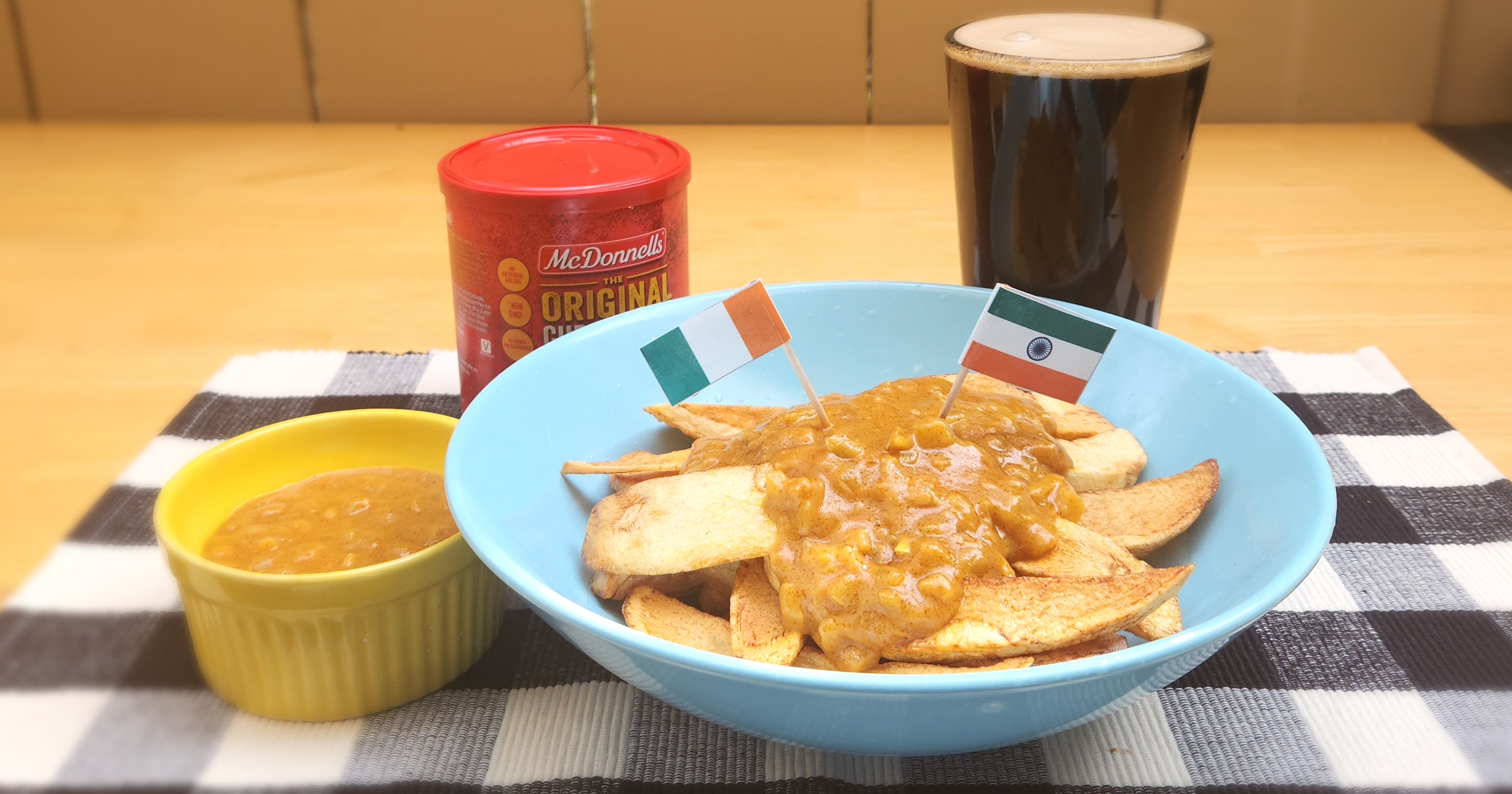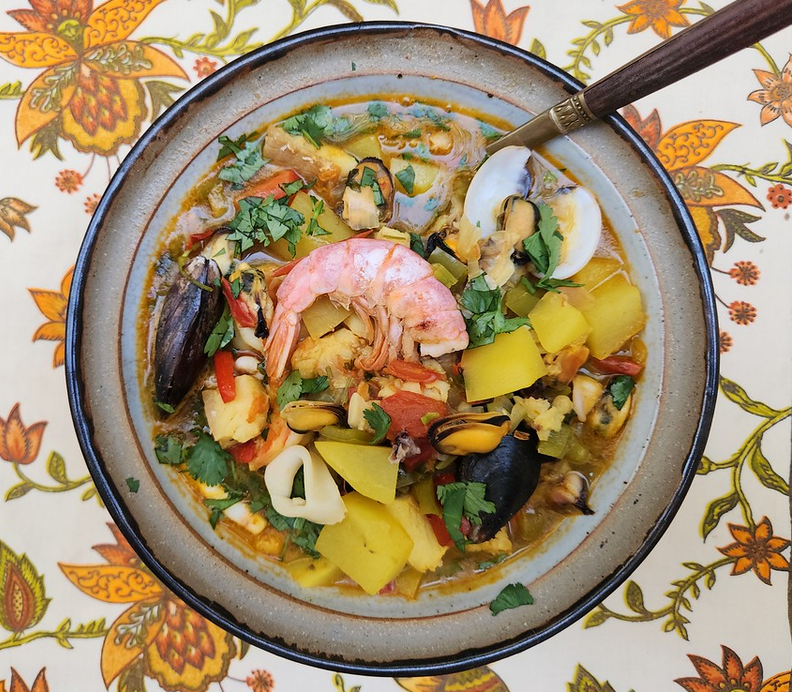Our Recipe for this month is Irish Chips with Curry Sauce. A pub and chip-shop favorite that blends the tastes of two great cultures!
A couple of decades ago, my family visited Ireland. It was a wonderful trip. Being a great fan of food from around the world, I must say, food was not exactly a highlight of our trip. While in recent times, nuevo and international cuisine has been making inroads into the Irish food scene, basic Irish food remains . . . rather basic.

One of the most essential foods in Ireland, Scotland, Wales and England are chips. Here in America, they are, of course, known as french fries, although perhaps more apropos would be steak fries as french fries (particularly in fast food outlets) are sliced much thinner. What we call chips, they call "crisps". According to the National Geographic, french fries became popular in the US after American forces returned from World War I. Many soldiers had tried fries in Belgium (and no doubt elsewhere) and because the dominant language in Southern Belgium is French, the fries became known as "french fries". However, ask the Nat G article states, the exact origin of this way of preparing potatoes has many competing claims. However, the french fry actually showed up in America much sooner, and Thomas Jefferson, who had made many trips to France, is generally credited with first bringing the now ubiquitous french fry to America. No doubt that even greater credit should go to Jefferson's enslaved cook, James Hemings (brother of the notable Sally Hemings). Hemings got his formal training in France as a cook when he was brought there by Jefferson when Jefferson was American Minister to France from 1784 to 1789.
Now "Chips" are a fundamental food in the English-speaking world, are a key ingredient in San Diego's "California Burrito" and have even found their way into gyros in Greece. In America, it is most common to eat french fries with catsup. However, throughout the world potato fries are eaten with a great variety of condiments and toppings. In the Netherlands, the favorite sauce is mayonnaise. In Canada, there is Poutine, which consists of fries, gravy, and curd cheese. In Bulgari, serine, a type of salty cheese, is preferred. France itself has a variety of popular condiments to complement fries: catsup, mayonnaise, Dijon mustard or a white sauce simply called "sauce pom frites". Icelanders enjoy their fries with a spice mix, catsup, or cocktail sauce. In South Africa, they are often soaked in vinegar until soft and are then known as "Slap Chips". But in Ireland and the United Kingdom, the greatest variety of sauces and condiments that are enjoyed with chips, including catsup, malt vinegar (typical for fish and Chips), brown sauce, BBQ sauce, Worcestershire sauce, mint sauce, cheddar cheese, gravy, salad cream, aioli, mustard, chili sauce, and last, but not least, curry sauce.
When we visited Kilkenny, we asked a local lad where was the best place to eat, and he suggested the "chip shop" down the street. When I asked him if they were good chips, his eyes glazed over as if he was descending into an ecstatic trance, and he replied "Ohhh Yes". So, my wife, daughter, and I followed the young man's directions and found the awe-inspiring chip shop. There was quite a line of folks waiting for their potato fix. It was not a shop in any normal sense. It was a building with a single door in the front, and the doorway led into a long hallway the end of which was a Dutch door where the chips of legend were being dispensed. We got ours, all wrapped up in paper. I don't recall what sauce we used (probably catsup). But I have to confess, I (and my family) were unimpressed. The chips were, again, larger than the most common type of french fry found in the US (as was expected). They were lightly fried and rather limp. They did taste very potatoey, but other than that, we were left wondering what all the hubbub was about. We decided that perhaps chips would not be part of the rest of our Irish adventures.
That changed a few days later when we visited the lovely little village of Avoca in Wicklow. Avoca is where the long-running Irish dramedy "Ballykissangel" was filmed. Most of the filming in Avoca (except Kathrine's General Store) was of the exteriors of buildings and the surrounding countryside. Interiors were more often than not filmed in a studio. Fitzgerald's pub, however, is a real pub, and we downed a few there (but again, interior shots of the pub were shot in a studio, the interior of the real Fitzgerald's is quite differently laid out). However, we did have a revelatory experience in Avoca having to do with the chips we swore off of. We went to a shop selling chips, and I noticed that one of the options to have with our chips was "curry sauce". Intrigued, we thought we'd give it a go. After taking the first bite, my eyes glassed over. . . the curry took the lowly chips to a whole different realm of sensuality. I was hooked.
When I began doing research for this recipe, I learned that my prior assumptions about the curry sauce for fries were wrong. I had thought that curry was a rather recent addition to the Irish palate, brought by South Asians who had recently emigrated to England. That is partly correct, but to my surprise, I learned that curry sauce has been enjoyed in Ireland for a very long time. Both Ireland and India were British Colonies, and while their experiences were often quite different in kind and degree, there is a kinship between the two countries, although it should be noted that some Irish, in the service of the British colonial apparatus, were notoriously brutal towards Indians. On a more positive note, a stalwart freedom fighter named Annie Basset was elected to the presidency of the Indian National Congress in 1917! According to an article in the Irish Times, the first Indian writer to write in English was Dean Mahomed who married a woman from County Cork after he arrived in Ireland in 1784. He also started the first Indian restaurant andm among many other notable achievements, also coined the term "shampoo" with "shampoo baths" becoming the central feature of the chain of spas he built, the first being in Brighton. Over the succeeding centuries, Indian food became more and more popular in Ireland. And perhaps curry and curry sauce led the way. It was just a matter of time before culinary syncretism created the birth of "chips with curry sauce".
Irish curry is generally milder than typical curries from India (although mild Indian curries certainly exist). Irish curry sauce also tends to be sweeter than Indian curry. Apples are often used to impart this sweetness. There are commercial powders that can be used to make Irish curry sauce: Knorr makes one and the Irish company, McDonnells makes several varieties including "original", "hot", and "mild". The curry powder is not used alone to make the sauce: there are additional spices and flavorings used to make the sauce.
Cook's notes: I caramelized the onions and apples for a richer taste. If you are in a hurry, you can sauté the onions until they are soft, and then add the diced apple and cook for another 2 minutes.
Making good "Chips" takes some advanced preparation. Peel and slice the potatoes and then soak them in cold water overnight. Pat dry the chips with a paper or cloth towel and, if you are frying them in oil, do so at 350°F. Air frying them might take 20 minutes or so at 400°.
Ingredients:
- 1 large onion, diced
- 1 large apple, peeled and diced (optional)
- 1 teaspoon minced garlic
- 1 teaspoon minced ginger
- 2 tablespoons curry powder (adjust for spiciness)
- 1 teaspoon ground turmeric
- 1 teaspoon ground cumin
- 1 teaspoon ground coriander seeds
- 1 teaspoon ground cinnamon
- 3 tablespoons butter
- 3 tablespoons all-purpose flour
- 2 cups chicken or vegetable broth
- 1 teaspoon Worcestershire sauce
- 2 teaspoons sugar
- 1 tablespoon tomato paste
- Salt to taste
Preparation
- Mix all the dry spices in a small bowl.
- In a thick-bottom pan, sauté the onions for 4 to 5 minutes on medium-high heat, stirring frequently.
- Add the diced apple and cook for an additional 2 to 3 minutes.
- Lower the heat and cook the onion-apple mixture for an additional 20 minutes, stirring frequently.
- Stir in the garlic and ginger, and cook for another minute.
- Add all the dry spices.
- In a different pan, melt the butter on medium-low.
- Add the flour, mix until it is all incorporated, and cook for 3 minutes while stirring.
- Whisk in the broth, Worcestershire sauce, sugar, and tomato paste.
- Cook until the sauce thickens.
- Mix the sauce in with the onion-apple mixture.
- Cook the curry sauce on medium-low for 10 minutes to blend the flavors.
- Season with salt (a bit at a time).
- Make chips (fries) in the manner of your own choosing and then adorn them with piping hot Irish curry sauce!
Recipe and photos by T. Johnston-O'Neill









